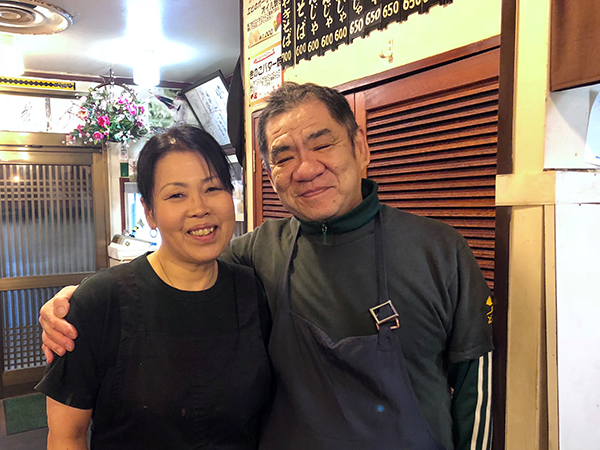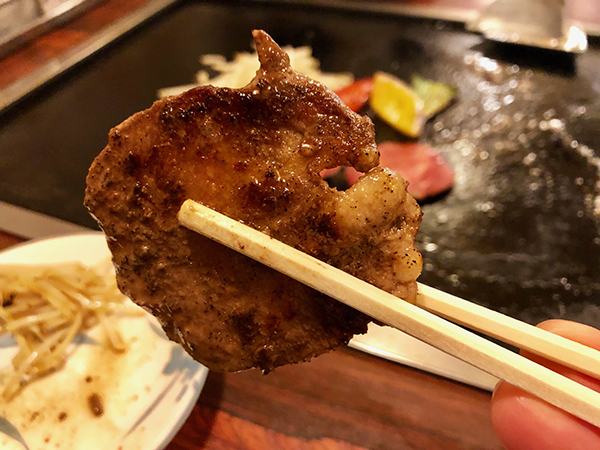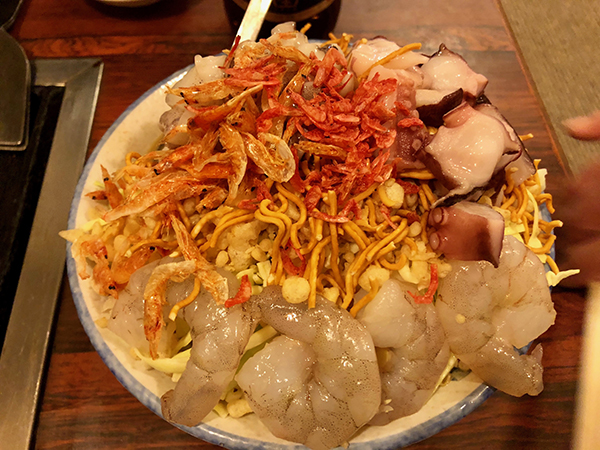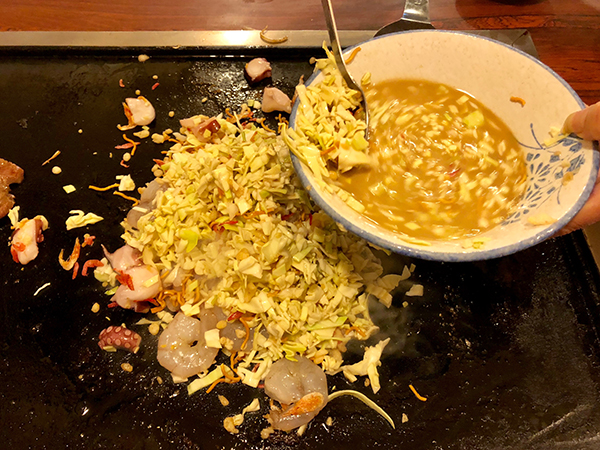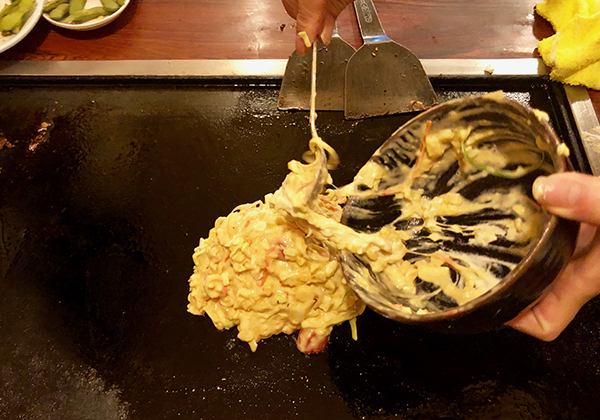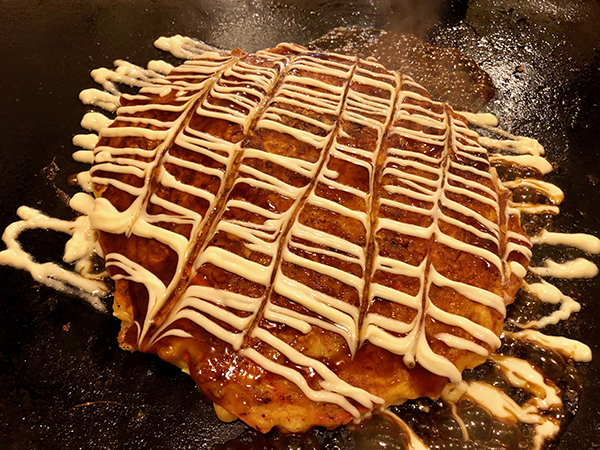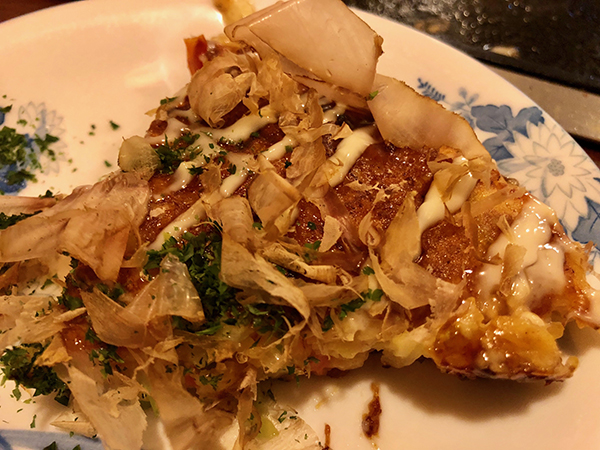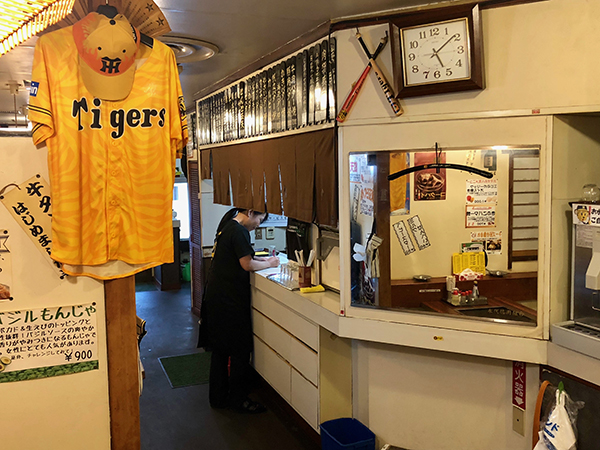Monja Magic at Okonomiyaki Dondo
Published: March 18, 2019
Monjayaki, affectionately known as monja to its devotees, is a distinctly Tokyo food. While its ultimate origin may be lost in the distant mists of the Edo Period (1603~1868), the modern version developed in Tokyo in the 1950s as a thin, salty pancake cooked on a griddle and topped with a variety of items. Over the last 30 years or so it has bloomed into a genre of its own, with a proliferation of restaurants in the east of the city. On a recent evening we dropped into Okonomiyaki Dondo, a hotplate cooking restaurant in Higashisuna, for a history and culinary lesson from its third-generation owner, Ms. Hiroko Masaki.
“As children we used to eat monjayaki cooked on a hot plate at the corner sweet shop (dagashi-ya) for our afternoon snacks,” remembers the warm-hearted and kindly Ms. Masaki. “I used to sneak eggs out of the fridge and take them down to be mixed into the batter. The monja cost around 20 yen apiece, I think. There was also a man who came around pulling a two-wheeled cart with a hot plate on it. He’d stop and cook up monja for the kids and local people. Around his neck he wore a small drum that he’d beat to announce his arrival. Don-don-don, like that. As a small kid I couldn’t say don-don; it came out as dondo so that’s what my parents named the restaurant. It’s real Tokyo old-town food. My husband hails from Ibaraki Prefecture near Tokyo and says they didn’t have monja there when he was a child.”
Ms. Masaki runs the restaurant together with her husband Koji, who worked as a chef for 30 years. “My parents opened Dondo in 1981. My older brother took charge for a spell and now we’ve been managing it for around ten years,” she said. “What’s changed in that time? Well, my husband’s a French and Italian chef so he’s added a Mediterranean influence on the menu and the number of items on the menu has increased dramatically.”
Ms. Masaki fires up the hot plate, before adding a touch of oil and a dab of butter. We start off with some beef tongue, thick cut and juicy. Kampai!
Cooked to perfection and doused in lemon juice, it’s the perfect way to begin.
Monjayaki is a flour-based food with the essential ingredients varying little. Soft flour (hakurikiko in Japanese), low in protein and commonly used for cakes and biscuits, is mixed with a broth (dashi) to form a runny batter. Toppings are cooked on the hot plate before the batter is added and the whole thing is then cooked together. This is the best seller at Dondo, the mixed seafood monja, containing a veritable smorgasbord of marine delights: big fat shrimp, squid, octopus and small dried shrimp, plus cabbage, tempura nubbins and the crunchy snack noodle Baby Star.
The broth is a key factor and remains a closely-guarded secret for many monja makers. Aside from the ingredients, successful monja construction is down to the dexterity and timing of the cook. First, the toppings are quickly cooked on the griddle, with most of the liquid left in the bowl.
Her hands are a blur as Ms. Masaki flips and shovels the monja mix to ensure that it all cooks evenly without burning. As it cooks, she fashions it into the famous doughnut shape and pours the remaining batter into the central lagoon.
Another burst of furious action with the spatulas, the steam billows and it’s ready to be topped with some dried bonito flakes and green dried seaweed powder. Dondo has 21 different varieties of monja on the menu, ranging in price from 650 to 850 yen. In addition to the sets, you can mix and match another 25 items from the toppings menu.
It’s great. Rich, savoury and piping hot, it goes down smoothly with cold beer. The heat is turned down low and the underside browns slowly, becoming superbly crispy and crunchy. Monja is traditionally eaten with small spatulas which are ideal for scraping it off the hot plate.
You would be forgiven for assuming that this another monja bowl but it’s not. Okonomiyaki hails from Western Japan and is most closely associated with Osaka and Hiroshima. Like monja it’s batter-based, savoury and cooked on a hot plate but there the similarity ends. Okonomiyaki uses a different kind of flour, different seasonings and contains yam and egg. Monja batter is thinner and runny, whereas Okonomiyaki is much thicker.
As Ms. Masaki explains, “The key to making a good okonomiyaki lies in mixing the ingredients very strongly in the bowl to add as much air as possible before you even start cooking it. The more air in the batter, the lighter the okonomiyaki will be.” This is pizza okonomiyaki, one of 16 different varieties on the menu; in addition to vegetables, shrimp and pork it contains cheese and tomatoes, as well as egg. After furiously mixing the thick batter for several minutes Ms. Masaki empties the bowl onto the hotplate and allows it to cook.
Okonomiyaki is cooked in oil only. She browns it on both sides, then brushes the top with okonomiyaki sauce and mayonnaise before cutting it into slices.
Finally, bonito flakes and powdered seaweed are added. Okonomiyaki sauce usually contains tomato ketchup, Worcester sauce, soy sauce and honey or sugar.
The okonomiyaki is delicious, with the cheese and tomato adding an extra piquancy to the already very savoury pancake. Although they may not look it, both okonomiyaki and monja are exceptionally filling, so it’s wise not to have eyes bigger than your stomach. Both are great though and very reasonably priced.
The menu at Dondo also includes a variety of hot plate items (teppanyaki). Customers can enjoy cooking beef, pork seafood and various vegetables in butter. According to Ms. Masaki, the “pirate fry” (kaizoku yaki), which features a vast array of seafood and vegetables is top value at 3,800 yen. “It’s enough for 4 people,” she says. Hot plate restaurants like Dondo are very sociable places; customers can eat, drink and talk at a leisurely pace as they enjoy cooking the food in front of them.
The drink menu is equally extensive. Beer is bottled Sapporo or Asahi on draft, with a dozen kinds of sours, plus wine, cocktails, sake, shochu and a wide array of non-alcoholic drinks for younger patrons or non-drinkers. “We get a lot of sports clubs, soccer teams, baseball teams, PTA meetings, office parties and so on,” says Ms. Masaki. “Larger groups of 20 or 30 can hire Dondo for the evening.”
Such is Dondo’s nostalgic feel as a “Showa Retro” restaurant that it was featured on the very popular Kenmin Show television programme recently. “We only had to take down a few of the more modern posters,” says Ms. Masaki, laughing. The food is wonderful and the welcome hearty; do yourself a favour and enjoy a real old-town style dinner at Dondo. You won’t regret it!
Story and Photos by Stephen Spencer


